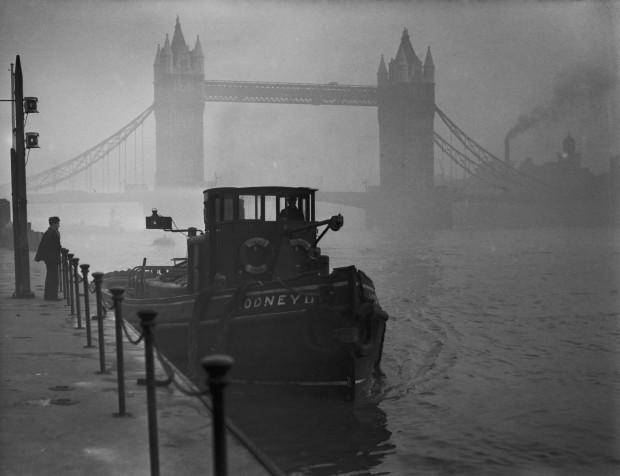Deadly London smog incident recalled on 60th anniversary
A tugboat on the Thames near Tower Bridge is moored in heavy smog during the Great Smog of December 1952. (Photo by Fox Photos/Hulton Archive/Getty Images.)
Sixty years ago this week was one of the deadliest episodes in the history of London.
On Dec. 5, 1952, an early-winter fog descended on the British city, enveloping it for four days. It was so thick that visibility was reduced to mere yards.
Now it’s true that London and fog are hardly strangers.
Charles Dickens put it well in Bleak House: “Fog everywhere. Fog up the river where it flows among green airs and meadows; fog down the river, where it rolls defiled among the tiers of shipping, and the waterside pollutions of a great (and dirty) city.”
But the events of 1952 were far from ordinary.
“The Great Smog of 1952 was the worst smog that London’s ever seen,” said Georgina Young, senior curator of contemporary istory at the Museum of London. “It was the ultimate ‘pea-souper,’ the worst instance the city ever had.
A high-system settled over the city, which, combined with very little wind, trapped the air over the city, she explained.
“It was very cold. Everyone had their house fire on, and at the time houses were normally heated by coal fires. And the smoke that those produced went into this pocket of air all over the city,” Young said. “They were added to by emissions from industries, and they are all going into the same pocket of air that was not moving anywhere.”
Iris Humphries, who was 21 at the time, remembers how dirty it was.
“We used to wear petticoats, and the hems were black,” she said. “Your hair was grimy, and you could feel the grit in the air, because it was coal smoke that made this fog. It was just choking and dreadful.”
And, for some, it was deadly.
Rosemary Merritt was a schoolgirl back in 1952. Her father worked at a London bus garage and suffered from bronchitis.
Because of transport disruptions, he was forced to walk an hour and a half through the smog to get home. Merritt remembers him walking through the front door.
“He was not breathing very well, and coughing quite a lot,” Merritt said. “We went to bed, and in the middle of the night, I was woken up by my mum banging on doors. My father had been taken worse, and my mum was really worried about him, because he was going blue apparently.”
Merritt says the doctor couldn’t even make it to their house. So, she and her mother tried to go and get medicine.
“We got to the doctor’s, picked up these tablets, and came back home,” she recalled. “We were greeted at the front door by the neighbors who had looked after my dad, to tell my mum he’d died.”
Merritt’s father was one of more than 4,000 people thought to have died as a result of the Great Smog of 1952.
“It was the combination of coal smoke with sulfur dioxide,” said Dr. Robert Waller, who was working in London’s St. Bartholomew’s hospital at the time.
“People were dying in their homes, and in the hospitals. They were mainly elderly people with existing cardio-respiratory disease,” he said.
At the time, no one noticed that the death toll was rising.
“There weren’t bodies lying around the streets,” he said. “One of the first indications that things were happening is that undertakers were running out of coffins, florists were running out of flowers.”
After four days, the deadly smog finally cleared.
The British government formed a commission to recommend steps to ensure such a thing never happened again. In 1956, Britain’s Parliament passed the Clean Air Act, which introduced a number of measures to cut down on the burning of coal.
But on this 60th anniversary of the Great Smog, some say London still has significant pollution problems. The environmental organization ClientEarth says even today an estimated 4,300 Londoners die each year as a result of air pollution.
The culprit now is not coal, the group says, but vehicle emissions.
